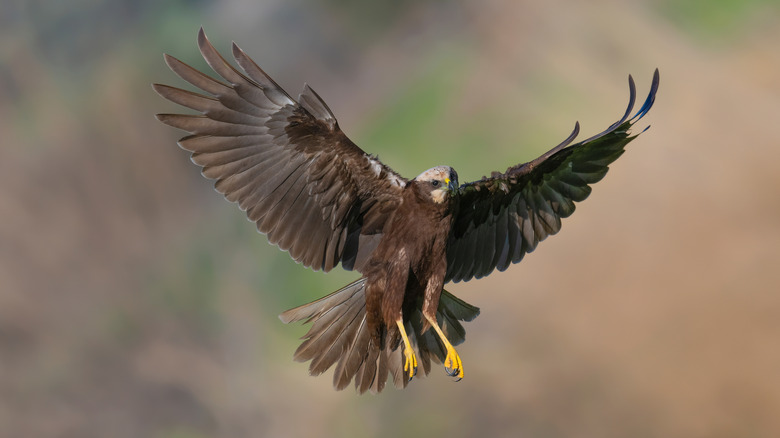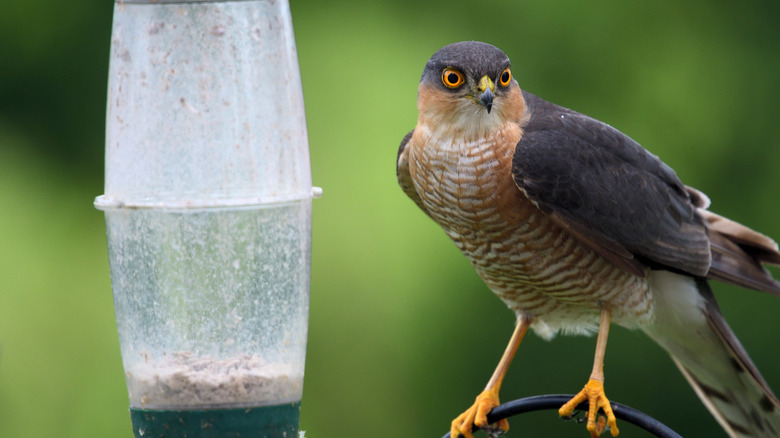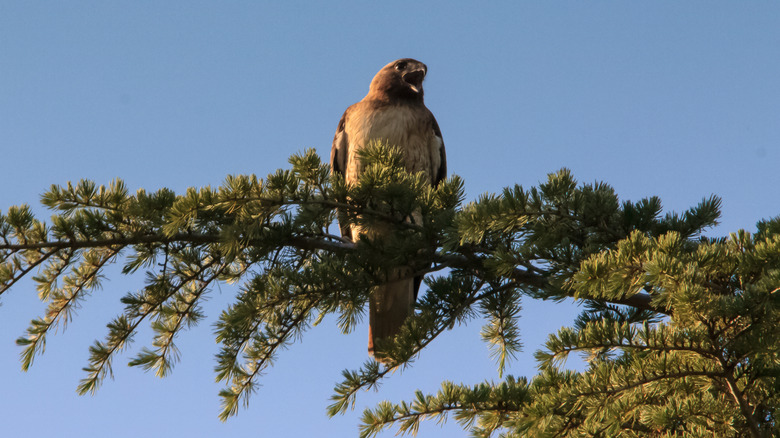Signs Of A Hawk Lurking Around Your Yard (& What's Attracting It)
If you suspect that a hawk is hanging around your backyard, you may be right. Hawks are becoming more common in suburban and even urban neighborhoods. Opportunistic predators like Cooper's hawks, widely found all over North America, are seeking out backyards more than ever before for their abundance of prey. Hawks are especially active in the wintertime, as fewer daylight hours and scarcity of food sources require them to work harder for their next meal. There are several ways to confirm your suspicions that a hawk is lurking nearby, such as inactive bird feeders, small animal remains, and scattered feathers in your yard.
Hawks are especially drawn to areas with tall trees where they can perch and build nests. However, as they adapt to urban environments, they may use objects like telephone poles and fence posts as substitutes. Look up in the trees around your home and you may even spot a hawk's nest, characterized by big bunches of sticks decorated with feathers and green foliage.
You might not be thrilled to have a Cooper's hawk in your yard, as they pose a significant threat to smaller birds, namely Rock Pigeons and Mourning Doves. On the other hand, some hawks in your yard are a good sign for hummingbirds. Hummingbirds aren't typically targeted by hawks, so they sometimes build nests in areas frequented by hawks to ensure that other predators will not interfere.
Hawks can be attracted to bird feeders and birdbaths
If you notice that your bird feeder has suddenly been abandoned with no signs of activity, chances are that the feathered friends who frequent your feeder have been alerted of a hawk nearby. In fact, your bird feeder is likely what is attracting hawks in the first place, as it creates the perfect environment to observe and hunt prey. Hawks are also known to frequent bird baths, so if you have one in your yard, it could attract raptors looking for a place to cool off.
Many hawk species, including the prolific Red-tailed hawk, will watch their prey from the treetops and wait for as long as it takes — sometimes hours — to strike. Intelligent birds know to stay far away until the coast is clear. Thankfully, you can keep hawks away from your bird feeder by placing it strategically away from predator areas and providing a few hiding spots for birds to escape to. With this being said, it is important to keep your feeder far away from windows, as the sudden presence of a hawk may startle the birds at your feeder and cause them to collide with a window as they attempt to flee.
Look and listen for signs of hawks
The presence of hawks in your yard may also be accompanied by certain visual and sound cues. Listen closely and you may notice an increase in bird calls around your property. These calls may sound like cheerful melodies, but in reality, they could be urgent warnings. Birds have a remarkably advanced communication system, especially when alerting each other of potential danger like a hawk. The warning call is not only shared across bird species, but it also travels up to 100 miles an hour, ensuring all the birds in the vicinity are aware of the predator's presence.
One of the more ominous signs that a hawk has been on your property is scattered bird feathers on the ground. Hawks often use their talons to grab their prey, plucking feathers in the process. If you notice feathers and other remains, particularly ones with V-shaped bite marks, you can be certain that a hawk had a successful hunt right in your backyard. Of course, the clearest sign of a hawk nearby is the sound of its unmistakable loud screech as it soars through the air.


